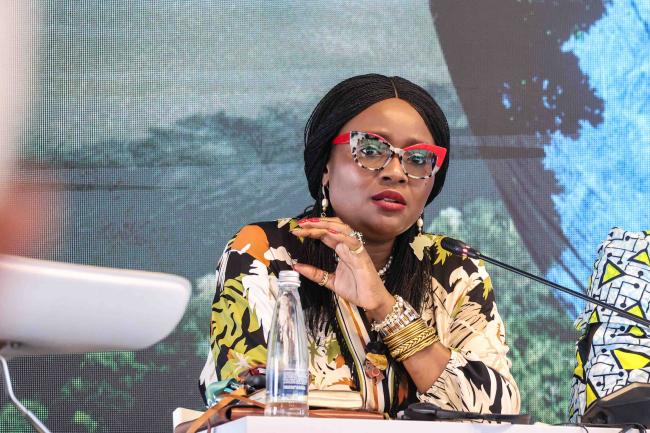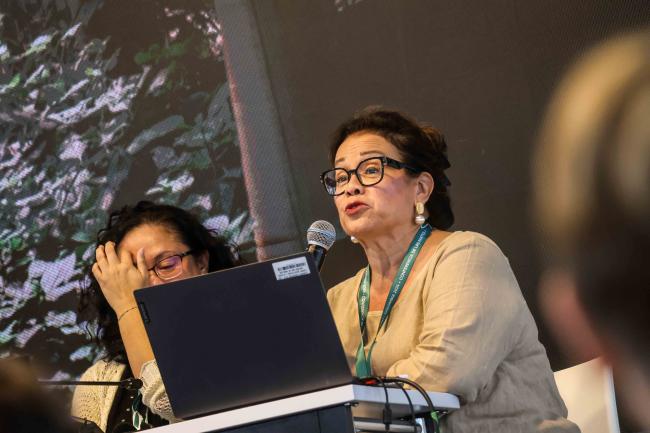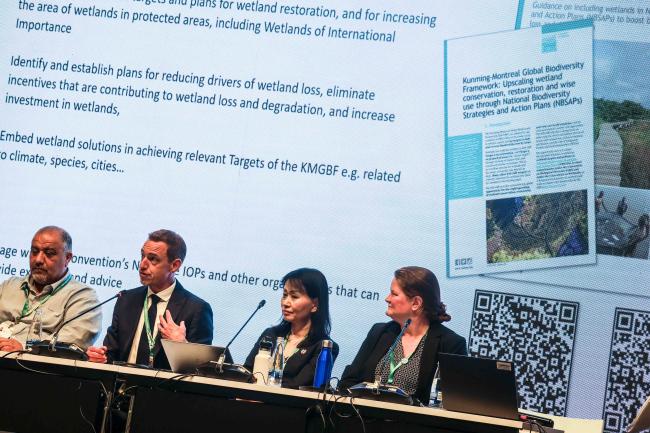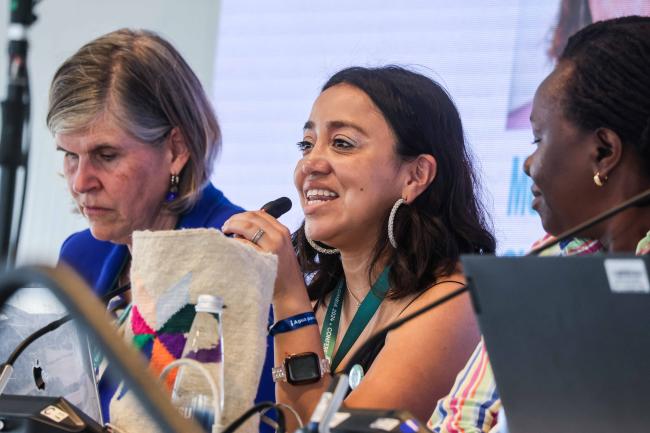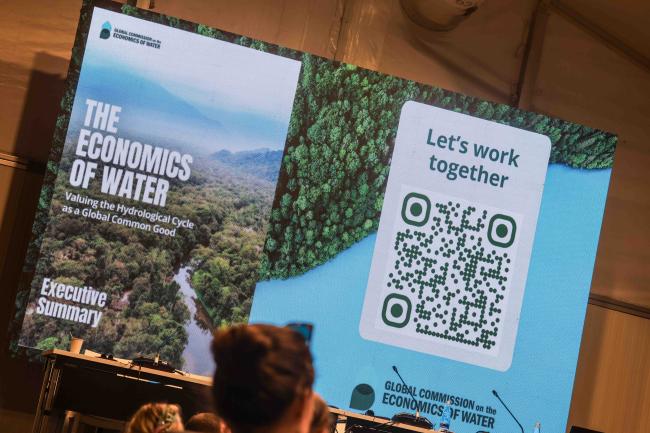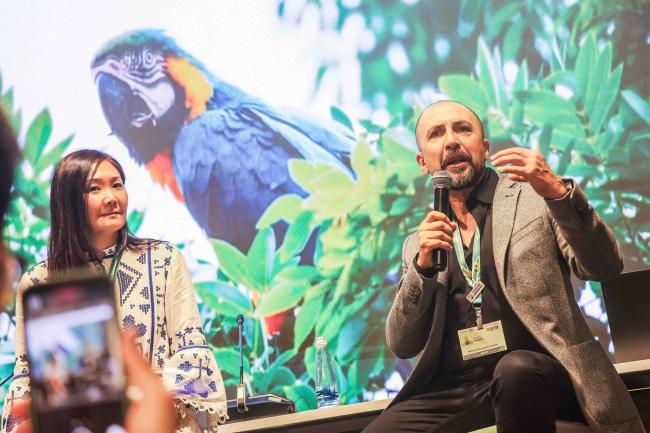About
This all-day event included distinct sessions focused on the interlinkages between forests and water-related ecosystems as key to implementing the Kunming-Montreal Global Biodiversity Framework.
From Cali to Belém: High-level Opening
Moderator Meike van Ginneken, Special Envoy for International Water Affairs, the Netherlands, opened the event, noting the critical role of forest and water interlinkages for conservation, restoration, and sustainable use of resources.
Attendees heard a video message from Zhimin Wu, Chair, Collaborative Partnership on Forests, and Director, Forestry Division, Food and Agriculture Organization of the UN (FAO), who said the global extinction rate of forest species is now 1,000 times higher than historical records. He announced the launch of a joint publication by the Convention on Biological Diversity (CBD), FAO, and the UN Forum on Forests (UNFF), The role of protection, restoration and sustainable management of forests for the implementation of the Kunming-Montreal Global Biodiversity Framework, and called for better integration of forests into National Biodiversity Strategies and Action Plans (NBSAPs).
The keynote speaker, Juan Carlos Jintiach, Global Alliance of Territorial Communities (GATC), Ecuador, highlighted the shared cosmovision of Indigenous Peoples regarding water, forests, climate, and biodiversity as interconnected issues. He called for the inclusion of Indigenous Peoples in decision making to meet biodiversity and climate goals and outlined five essential requirements for their effective participation: recognition of land rights; free, prior, and informed consent (FPIC); access to direct financing; protection of life; and respect for traditional knowledge.
Bahodur Sheralizoda, Committee for Environmental Protection, Tajikistan, addressed the water-biodiversity nexus, highlighting Tajikistan's leadership on the global water agenda, especially with respect to glacier preservation. He said the country’s glacier ecosystems are vital for water and biodiversity but face threats from climate change. He emphasized the essential connections between water, biodiversity conservation, and climate action.
Juliette Biao, Director, UN Forum on Forests, said it is impossible to achieve effective implementation of the GBF without leveraging the UN Strategic Plan for Forests 2017-2023, the first-ever plan of its kind. She highlighted the importance of taking a holistic view of interlinkages, and emphasized the importance of helping leaders see the whole picture. She also noted that the Forest Pavilion at international meetings provides a space where leaders and partners can discuss forest management issues.
Musonda Mumba, Secretary-General, Convention on Wetlands of International Importance Especially as Waterfowl Habitat (Ramsar Convention), noted that it is one of the oldest multilateral agreements. She emphasized that wetlands played a critical protective role when two hurricanes converged in Florida, US, earlier this year. She said “Life is not lived in pizza slices; we live in a very holistic way, in a collective, and so does nature.”
Maggie Charnley, Head, International Forest Unit, UK, lamented the misplaced emphasis on short-term values of forest services. She called for ensuring that discussions at the “three Rio Conventions” (UN Framework Convention on Climate Change, CBD, and UN Convention to Combat Desertification) keep forests in mind. She also highlighted the importance of climate finance, governance, and enforcement, and lauded the increased inclusion of Indigenous Peoples and youth.
Rita Mesquita, Ministry of the Environment and Climate Change, Brazil, outlined the close connection between forests and water, from rainforests to wetlands to dry savannahs. She noted they are completely connected and that disruptions in the recycling of water impacts entire ecosystems. She highlighted Brazil’s commitment to restoring 12 million hectares of native vegetation, including on private lands, and its goal of achieving zero deforestation.
Oscar Puerta Luchini, Ministry of Environment and Sustainable Development, Colombia, invited panelists to comment on their goals, expectations, and priorities for scaling up action. Summarizing the panel discussion, van Ginneken said water and biodiversity should not be thought of in silos and urged “action, action, action.”
A Human Rights-Based Approach to Conserving Forest Landscapes
The session highlighted the role of services and functions of a healthy forest in supporting livelihoods.
Fran Price, WWF, opened the human-centered session, saying it would offer opportunities to hear from Indigenous Peoples, women, and youth about their role in forest conservation.
Nohora Alejandra Quiguantar, ICCA Consortium, emphasized the importance of including Indigenous Peoples and local communities (IPLCs), traditional knowledge, and a human rights-based approach in biodiversity conservation. She advocated for support of the ongoing negotiations on Article 8(j) of the CBD (traditional knowledge, innovations, and practices of IPLCs), highlighting its role in securing direct financing and access to decision making. She stressed that IPLC participation should be viewed as a right, not a privilege.
Naw Eh Htee Wah, All Burmese Indigenous Peoples’ Alliance (ABIPA), stated that despite the significant contributions of IPLCs to biodiversity conservation, they face marginalization, militarized violence, and oppression. She emphasized that the COP 16 theme of “Peace with Nature” makes it crucial to also safeguard the lives of nature’s guardians.
Joyce Peshu, CBD Women’s Caucus, Kenya, highlighted that although women are vital to forest management, they often lack formal land ownership, leading to human rights issues like tenure insecurity and gender-based violence. She noted that even with progressive laws, patriarchal norms hinder women's access to rights and decision-making. She said the CBD Women's Caucus advocates for recognizing women as actors of change in the GBF and NBSAPs, not just as vulnerable individuals.
Joseph Itongwa, GATC, emphasized the need to include IPLCs in conservation efforts, noting they have not been respected or consulted during the establishment of the majority of protected areas in Central Africa. He said that despite being custodians of nature for millennia, IPLCs are excluded from resource management due to fortress conservation models. He urged stakeholders to center IPLCs in conservation strategies and implement a system for them to report and address human rights abuses.
Neema Pathak Broome, ICCA Consortium, praised the GBF as “groundbreaking” for prioritizing human rights in conservation, but noted it missed recognizing the significant contributions of Indigenous territories to conservation. She highlighted the disparity between international agreements and local implementation as a major challenge for a human rights-based conservation approach.
Jazzy Rasolojaona, Natural Justice, Madagascar, announced the release of a working paper on advancing human rights approaches to area-based conservation by the Human Rights and Biodiversity Working Group. He highlighted the importance of self-determination for rights holders and outlined steps for effective, socially-just conservation, including: respecting communal values, moving away from fortress conservation, ensuring meaningful FPIC, and resolving rights conflicts and violations.
Trevor Sandwith, International Union for Conservation of Nature (IUCN), concluded the session by emphasizing that respecting human rights is integral to IUCN’s work and imperative for long-lasting conservation action. Highlighting examples, he noted that social justice is both an outcome and a means to achieving conservation.
Forests in a Changing Climate: Biodiversity as a Safeguard for Resilient Forest Landscapes
In opening remarks, Maggie Charnley, UK, underscored that deforestation has exacerbated climate change. She described the Accelerating Innovative Monitoring for Forests (AIM4Forests), which focuses on supporting government and Indigenous-led forest monitoring and conservation efforts. She also highlighted use of technological innovation to enhance data transparency and unlock financing, including for “bespoke” training materials focused on vital stakeholders such as Indigenous Peoples.
Diel Mochire, Integrated Program for the Development of the Pygmy People, Democratic Republic of Congo, urged fighting against land grabs, extractive mining, pollution, and water contamination, noting that mapping and documenting can help acknowledge the importance of land for local livelihoods and culture.
David Garcia, International Land Coalition, said mapping and surveillance is still being used to suppress people across the world, but can also be used to protect, defend, and advocate for rights. A new collaboration between FAO and ILC was launched to scale up support to Indigenous Peoples for forest and land monitoring and mapping.
Elizabeth Kaidong, Papua New Guinea (PNG) Forest Authority, noted that logging is a key driver of forest degradation, and described different innovative monitoring systems to support sustainable forest management practices, including ones that enhance participation by Indigenous Peoples. She also emphasized the importance of work on existing policies and regulations, external funding, and technical support.
Yelena Finegold, FAO, said more than 60 countries have reported detailed forest reference levels to the UNFCCC, and now a similar scaling up monitoring and reporting across GBF Targets was required for NBSAPs. She emphasized the need for strong data on monitoring and reporting to support better decision making, build trust, and incentivize nature-based solutions.
Fabiola Zerbini, Brazil, said we are “living the consequences of biodiversity loss,” and stressed the importance of protecting secondary vegetation to recover biodiversity. She highlighted Brazil’s revised national policy to address deforestation and accelerate restoration, which involves 10 ministries, the private sector, academia, and local communities.
Clea Paz-Rivera, UN Development Programme (UNDP), spoke about the intersection of Nationally Determined Contributions (NDCs) and NBSAPs and the need to scale up action on both climate and biodiversity, saying that ambition should focus not only on targets, but also on quality. She emphasized the need for policy coherence and unlocking “double-win” finance models and noted support for a pilot AI project to analyze the intersections between NDCs and NBSAPs.
During the question-and-answer session, topics included a global pact on biodiversity and water, the need to recognize campesinos (farmers), benefits of restoration, and respecting the global expertise of local communities.
Sustainable Forest-Based Economies: Meeting the Needs of People and Biodiversity
Against the backdrop of increasing global demand for timber and agricultural commodities, this session explored the role of various stakeholders along the supply chain in ensuring sustainable forest management to benefit people, forests, climate regulation, and biodiversity conservation.
Erik Dhaenens, EU Commission, explained the new EU Regulation on Deforestation-free Products (EUDR), requiring the trade of seven deforestation-linked commodities to meet criteria of risk assessments, traceability, and compliance with country-of-origin legal standards, including those related to human, labor, and Indigenous rights.
Julian Fox, FAO, discussed efforts to assist producer countries in meeting EUDR's risk assessment requirements through regional workshops, institutional coordination, and geospatial risk assessment tools, including the newly launched "What is in that plot" Whisp Platform designed to support small holders and Indigenous Peoples comply with demand side regulations.
Sofia Hirakuri, STCP Engineering, highlighted Latin American examples to showcase the potential social, economic, and environmental benefits of integrating sustainable forest production, biodiversity conservation, and bioeconomy, along with challenges such as short-term profit tradeoffs, illegal logging, and traceability.
Juan Miguel Vásquez, Executive Director, National Federation of Wood Industries, (FEDEMADERAS), Colombia, urged stakeholders to rethink development models, emphasizing that sustainable development must balance environmental, social, and economic factors. He highlighted bioeconomy as a key opportunity for Colombia to meet global timber demands sustainably while pursuing development needs.
Maureen Whelan, Forest Service of Natural Resources, Canada, said biodiversity is an integral component of sustainable forest management, and shared details of laws and regulations in Canada that ensure sustainable timber supply.
Jennifer Conje, International Tropical Timber Organization (ITTO), showcased examples of ITTO’s efforts to promote biodiversity conservation through sustainable forest management practices, including the joint ITTO/CBD Collaborative Initiative for Tropical Forest Biodiversity, which has funded projects in 23 tropical countries to conserve biodiversity while maintaining the production of sustainable timber and other forest products.
In closing remarks, Ivonne Higuero, Secretary-General, Convention on International Trade in Endangered Species of Wild Fauna and Flora (CITES), emphasized that forests are foundational to climate, biodiversity, and socio-economic solutions for an equitable future.
Conservation and Restoration of Water-Related Ecosystems for Peace with Nature
In the afternoon, Jerker Tamelander welcomed speakers to the first session focused on Water.
This session showcased efforts to protect and maintain critical ecosystem functions. During opening remarks, Susan Gardner, Director, Ecosystem Division, UNEP, lamented that despite hundreds of water-related commitments, SDG 6 (clean water and sanitation) is one of the most underfunded SDG. She highlighted multiple tools and initiatives focused on freshwater ecosystems, including the Freshwater Ecosystem Explorer, which uses satellite imagery. She stressed the importance of integrated water resources management for both water and climate issues.
Henk Ovink, Executive Director, Global Commission on the Economics of Water, highlighted the recent release of a report by the Commission, which underscores the interconnected role of "blue" and "green" water ecosystems in maintaining hydrological cycles. He emphasized the role of Indigenous communities in conservation actions.
Constantino Aucca Chutas, Acción Andina, Asociación Ecosistemas Andinos (ECOAN) shared experiences from the Amazon River Basin, described a community-driven project that had planted millions of trees. He highlighted the role of Indigenous Peoples who want respect and to be part of the solution as stewards of natural lands.
Sandra Ponde, Department of National Parks and Wildlife, Zambia, outlined her country’s commitment, along with 46 other countries and the EU, to the Freshwater Challenge, which is focused on restoring and conserving freshwater ecosystems. She noted, as a challenge, incorporating freshwater targets and actions into national documents, and stressed the importance of cross-ministerial cooperation.
Obaid Alshamsi, Ministry of Climate Change and Environment, United Arab Emirates (UAE), highlighted his country’s lesser-known freshwater ecosystems and mangrove forests, work on protected areas, and efforts to reduce plastic pollution in freshwater bodies. He noted that the UAE will co-host the 2026 UN Water Conference.
Humberto Delgado Rosa, Directorate-General for Environment, European Commission, highlighted the challenges and urgency of ecosystem restoration in the EU. He described EU nature restoration regulations for different ecosystems, including agro-ecosystems, urban green spaces, rivers, and wetlands, and support for member states in developing restoration plans.
Femke Tonneijck, Director of Programme Impact, Wetlands International, described the critical role of wetlands as connectors between different ecosystems, highlighted a call to action by 140 organizations to support wetlands as nature-based solutions, and underscored the need for synergies across the Rio Conventions.
During a question-and-answer session, panelists addressed priority actions and the impacts of hydroelectric power.
Building Peace: Sustainable Use of Water-Related Ecosystems among all Stakeholders
This session was divided into two panels. The first discussed a whole-of-government approach, and the second considered a whole-of-society approach.
Whole-of-Government: Moderated by Manoela Pessoa de Miranda, Minamata Convention on Mercury Secretariat, the first three speakers shared experiences in engaging multi-level government agencies for a holistic approach to conserving and restoring water-related ecosystems.
Meike van Ginneken, the Netherlands, underscored the potential of spatial and economic planning to bring government officials together. She noted that while ministries are meant to serve the common good, they often prioritize sector-specific interests. She explained that spatial planning elicits debates on tradeoffs, fosters stakeholder collaboration, and encourages conscientious decisions about how different choices mean different distribution of costs and benefits.
Juanita de los Ángeles Ariza Guzmán, Accidental Commission on Water and Biodiversity, Colombia Senate, highlighted Colombia’s Senate and House efforts to prioritize communities’ rights to access water and biodiversity for socio-environmental conflict resolution. She also highlighted the National Water Network's role in empowering Indigenous and local leaders in decision making as essential for transformational change.
Anne Nakafeero, National Environment Manager, Uganda, discussed her country's whole-of-government approach to balancing gold mining’s revenue importance with concerns about mercury pollution. Through collaboration among ministries and stakeholder engagement, she said she has seen the mining sector's willingness to adopt clean technology and reduce mercury use.
Whole-of-Society: Mrinalini Rai, Women4Biodiversity, moderated the panel discussion and invited speakers to share concrete examples from their experiences in efforts to implement a whole-of-society approach.
Chris Dickens, International Water Management Institute (IWMI), South Africa, highlighted the value of data and 3D river basin models in ecosystem and water management. He discussed an IWMI project, carried out in partnership with Microsoft and ChatGPT, which aims to manage complex water data while enhancing citizen science and community engagement.
Silvia Benítez, The Nature Conservancy (TNC) Latin America, discussed her work on mercury pollution in the Amazon River Basin. She highlighted that over 50% of fish in the area are contaminated with mercury above World Health Organization safety levels. She said TNC is collaborating with IPLCs, civil society organizations, and the Minamata Convention to address mercury pollution and support affected communities.
Dario Mejía Montalvo, UN Permanent Forum on Indigenous Peoples, noted the disparity between the accelerating climate and biodiversity crises and the slow pace of policymaking. He noted that governments are finally acknowledging Indigenous Peoples’ traditional knowledge and cosmovision, which were historically dismissed as myths or beliefs. He criticized the CBD’s adoption of the term IPLC, arguing that lumping Indigenous Peoples with local communities only serves to undermine Indigenous rights and force assimilation.
Anke Manuela Salzmann, Boticário Group Foundation, Brazil, shared experiences and responses to the 2019 Brazilian water scarcity crisis. She noted that the water shortage threatened production, prompting businesses and stakeholders to collaborate on water security and climate adaptation through nature conservation and responsible entrepreneurship, resulting in the Viva Água Initiative.
During the question-and-answer session, participants discussed practical challenges in trying to implement a whole-of-society approach, including: data access, collection, cost, and complexity; monitoring capacity; integration of different world views and approaches to ecosystem and water management; and meaningful representation.
Water and Water-related Ecosystems in the GBF Implementation: NBSAPs, Monitoring and Financing Mechanisms
Monica Kobayashi, CBD Secretariat, opened the last panel of the day, which included national experiences in implementation and monitoring and discussions on the needs, barriers, and opportunities to include water and water-related ecosystem targets in NBSAPs.
Carlos Nobre, University of São Paulo, Brazil, highlighted the Amazon’s role in the carbon cycle, noting its transformation from a carbon sink to a source, with increased drought and deforestation exacerbating the problem. He said the Amazon is reaching a tipping point due to the warming Ocean and deforestation, and called for a goal of zero deforestation, accelerating forest restoration, and leveraging Indigenous knowledge and nature-based solutions.
Belal Qtishat, Ministry of Environment, Jordan, noted his country’s unique biodiversity, including its highly resilient coral reefs. He described work on marine protected areas, woodlands, and wetlands, including by local communities.
Eileen Burke, World Bank, stressed the need to balance urban water needs, water for agriculture, and biodiversity conservation, emphasizing nature-based solutions and improved cross-sector water management. On integrated water management, she lamented limited progress toward achieving relevant SDGs and the few agreements on transboundary waters, saying a new approach is needed.
Midori Paxton, UNDP, emphasized that NBSAP updates are crucial for alignment with the GBF, noted that water is not yet well integrated into NBSAPs, and described a toolkit to help countries assess policy coherence and alignment.
Jerker Tamelander, Ramsar Convention on Wetlands, noted that water for agriculture is both a food security issue and a driver of wetland loss. He spoke about the need to stabilize the hydrological cycle and called for inclusive governance models.
During the question-and-answer session, speakers addressed topics such as Amazon drought impacts, ecological planning, and the need to connect water management with biodiversity protection.
In closing remarks, Henk Ovink summarized that the day’s sessions focused on scaling up forest-water initiatives, human rights-centered approaches, and accelerating NBSAPs, which are essential for building capacity, enabling data access, and supporting livelihoods. He stressed the interconnections of the hydrological cycle with all SDGs and the need for collaborative action to preserve water resources and restore the natural water cycle. Linking forests and water to upcoming international meetings on climate and wetlands, he said the “Road to Belém is a river that runs through Baku and Victoria Falls,” which will offer opportunities to seize global momentum for these partnerships and initiatives.
Juanita de los Ángeles Ariza Guzmán closed the event by announcing the launch of a Global Pact for Water and Biodiversity. She highlighted Colombia’s work to encourage leaders, organizations, and institutions from both the public and private sectors to acknowledge the interconnectedness of water, agriculture, and forestry in sustaining life and culture, and invited participants to sign the pact.
Reception
At the close of Forests and Water Day, participants enjoyed a talk-show style interview with Fernando Trujillo, 2024 Rolex National Geographic Explorer. He discussed his career as a marine biologist and conservationist, and his experience as an explorer. He highlighted that scientists often focus too much on issues in isolation, and the explorer experience allowed him to see the interconnectedness of everything. Trujillo shared an optimistic outlook on conservation projects that involve both people and nature.
Co-organized by: CBD, UNEP, Minamata Convention on Mercury, ITTO, WWF, Ramsar Convention on Wetlands, UN-Water, UNDP, IUCN, UNFF
In partnership with: GCEW, La Comisión Accidental de Agua y Biodiversidad del Senado de la República de Colombia, CPF
Contacts: Jamal Annagylyjova, CBD jamal.annagylyjova@un.org
Monica Kobayashi, CBD monica.kobayashi@un.org
For more information: https://www.cbd.int/conferences/2024/parallel-meetings/kmgbf-pavilion-forests-water-day
To receive free coverage of global environmental events delivered to your inbox, subscribe to the ENB Update newsletter.
All ENB photos are free to use with attribution. For the 2024 UN Biodiversity Conference, please use: Photo by IISD/ENB | Mika Schroder

